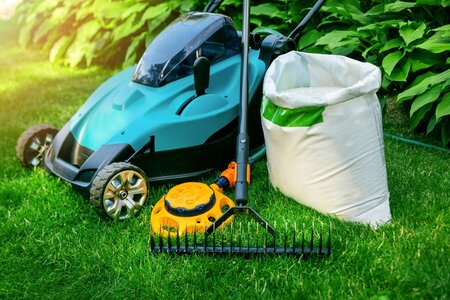
If you dream of a smooth green lawn in your garden this summer, now’s the time to start getting it into shape. As the days warm up and the grass springs back into action, putting in some work on your lawn now will pay dividends over the rest of the year. Here are our top 6 spring lawn care tips.
Spring lawn care tips
-
Aerate your lawn. If your lawn is small, you can use a garden fork to spike holes at regular intervals, focusing especially on any areas of compacted ground. Alternatively, use a hollow tine aerator, which removes small plugs of soil, leaving holes behind. This improves drainage on compacted soils and allows air to get into the soil and reach the roots of the grass, producing stronger growth. If your lawn is too large to be aerated by hand, mechanical aerators are available.
-
Mow your lawn with your lawnmower blades on their highest setting while the grass is still starting to grow. As growth speeds up over the next few months, gradually lower the blade setting. Don’t mow wet or frosty grass.
-
Scarify your lawn by raking it firmly with a spring tine rake or using a mechanical scarifier to clear out moss and thatch (dead grass). If moss is a big problem in your lawn, apply moss killer first and wait until the moss turns brown or black, then scarify. As with any chemical product, always follow the manufacturer’s instructions.
-
Feed your lawn with a spring lawn fertilizer, which is high in nitrogen to promote lush growth. This strengthens the turfgrass, thus reducing the opportunities for weeds and moss to get established. Check the instructions before applying, as lawn fertilizers often need watering in. Ideally, apply lawn fertiliser when rain is expected.
-
Tackle lawn weeds. Dig up deep-rooted weeds like dandelions with a dandelion grubber with a long thin blade with a notch at the tip. Insert the blade next to the root, twist around to loosen the root from the earth, then use the notch to sever the root at the base. If your lawn has too many weeds to dig up by hand, use a lawn weedkiller, which will target the weeds without killing the grass.
-
Fix bare patches by sowing seed or use a lawn patch repair kit, which contains seed and fertiliser. Before sowing, lightly dig over the soil's surface with a fork to break it up, then rake it smooth. Scatter the seed and rake over to cover it. Water regularly until the seed has germinated and the grass is well established, and don’t walk on the grass until after it is long enough to be cut.
Spend a little time and effort on your lawn this month – the results will be well worth it! We have a wide range of lawn care products and equipment in the centre, so visit us to get your lawn off to a great start this spring.







